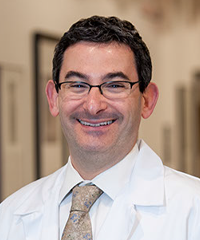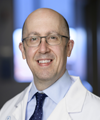Oncology
Relapsed/Refractory Diffuse Large B-Cell Lymphoma
Newer Options for Durable Disease Control in Relapsed/Refractory Diffuse Large B-Cell Lymphoma
Overview
Chimeric antigen receptor (CAR) T-cell therapy is a newer, potentially curative treatment when used after 2 or more lines of systemic therapy in relapsed/refractory diffuse large B-cell lymphoma (R/R DLBCL). In addition, options for durable disease control in the R/R setting now include loncastuximab tesirine and tafasitamab plus lenalidomide.
What are some of the newer curative intent options, as well as options to achieve durable remissions, for R/R DLBCL?
Jeremy S. Abramson, MD, MMSc
|
|
“DLBCL is a highly treatable disease, with opportunities for cure in the second- and third-line settings, and it is good for patients to know about all of their options.”
Patients are very happy to have additional options for the treatment of R/R disease. Even at the time of initial treatment, many patients with DLBCL are understandably concerned, and they may have a lot of “what if” questions in the back of their minds. DLBCL is a highly treatable disease, with opportunities for cure in the second- and third-line settings, and it is good for patients to know about all of their options.
We have 3 CAR T-cell therapies for R/R DLBCL (ie, axicabtagene ciloleucel, tisagenlecleucel, and lisocabtagene maraleucel). This approach can be a good third-line treatment option even for older, frail patients who otherwise would not be considered to be good candidates for high-dose chemotherapy (HDC) and autologous hematopoietic stem cell transplantation (auto-HSCT) in the second-line setting. CAR T-cell therapy is generally safe, and it may even be easier to tolerate than HDC and auto-HSCT, particularly when using the 4-1BB costimulatory products (ie, tisagenlecleucel and lisocabtagene maraleucel).
There are ongoing randomized trials comparing CAR T-cell therapy with salvage therapy followed by HDC and auto-HSCT in high-risk patients with DLBCL. Based on preliminary data releases from these studies, we anticipate seeing a superiority of CAR T cells in this population of patients, who had primary refractory disease or relapsed within 1 year of initial treatment. Once we see that data, an outstanding question will then be: Would CAR T-cell therapy supplant auto-HSCT for all patients? That is, it is not known how an updated US Food and Drug Administration (FDA) label might read, including whether the indication would be limited to patients with early progression or primary refractory disease or whether it would be broad enough to include other groups of patients, including those who are considered to be transplant ineligible. I think that we will likely see a shift in the standard of care for a significant proportion of patients.
We also have newer treatment options for those who are not proceeding to CAR T-cell therapy or who relapse after CAR T-cell therapy. Notably, loncastuximab tesirine and tafasitamab plus lenalidomide both target CD19, and each may produce prolonged remissions in the R/R setting. Loncastuximab tesirine was granted accelerated approval by the FDA based on the LOTIS-2 trial, which was conducted in a heavily pretreated DLBCL population. It is given for a fixed duration and has produced durable responses as third-line or later therapy, with approximately one-third of patients remaining progression free at 1 year. In the L-MIND clinical trial of tafasitamab plus lenalidomide, the population was not exceptionally high risk, but approximately 40% of patients have remained progression free, even beyond 2 years. Tafasitamab is given every week for 3 months and then every 2 weeks indefinitely, so this is essentially a maintenance therapy, whereas, as noted above, loncastuximab tesirine is a fixed-duration therapy. Tafasitamab plus lenalidomide is FDA approved for use as early as second line in DLBCL.
Brad Kahl, MD
|
|
“With CAR T-cell therapy, the patient population that can be treated with curative intent has been expanded, which has been a wonderful development in the field.”
When deciding on a potential therapy for patients with R/R DLBCL, we always consider the curative intent options first. There are now several available treatment options that have the potential to cure patients who have not been cured by standard chemoimmunotherapy. Historically, the path to potential cure in this setting was HDC and auto-HSCT; allogeneic HSCT has not been widely used, but this is another strategy that has resulted in cure for some patients.
The availability of CAR T-cell therapy has afforded us with another curative intent option. CAR T-cell therapy can work in patients for whom chemotherapy is completely failing. These are individuals whom, historically, we had no chance of curing, but there is now an approximate 30% to 40% likelihood of cure in these patients. That is a huge advance in the treatment of DLBCL. Importantly, through experience, we have learned how to extend these therapies to more patients, such as those who are older or frail. With CAR T-cell therapy, the patient population can be treated with curative intent has been expanded, which has been a wonderful development in the field.
Matthew J. Matasar, MD
|
|
“There are also other recently FDA-approved and newly emerging treatments that may offer the opportunity for curative intent. These therapies are promising, and we are hopeful, but it is too early to tell.”
Among patients with R/R DLBCL, our therapeutic intent remains focused on cure. Cure is obtainable for a subset of these patients. For those who are currently eligible for transplantation, we pursue cure with platinum-based chemotherapy followed by auto-HSCT. For patients who are transplant ineligible, we may still be able to offer CAR T-cell therapy, and, based on the 5-year follow-up data that we have on CAR T-cell therapy, we can offer the potential for cure in a subset of patients (ie, in approximately one-third), despite this being R/R disease.
There are also other recently FDA-approved and newly emerging treatments that may offer the opportunity for curative intent. These therapies are promising, and we are hopeful, but it is too early to tell. For example, with polatuzumab vedotin plus bendamustine/rituximab, we know that there is a subset of patients who remain relapse free far beyond the median progression-free survival. However, we do not have data at 5 years, so it is uncertain whether this has curative potential. Similarly, data on tafasitamab plus lenalidomide and loncastuximab tesirine look promising, and we remain hopeful for curative potential. There are also other novel therapies, including bispecific antibodies and other types of CAR T-cell therapy, that offer the potential of cure, but these are too early in clinical development to know whether they will become a reality.
References
Bataillard EJ, Cheah CY, Maurer MJ, Khurana A, Eyre TA, El-Galaly TC. Impact of R-CHOP dose intensity on survival outcomes in diffuse large B-cell lymphoma: a systematic review. Blood Adv. 2021;5(9):2426-2437. doi:10.1182/bloodadvances.2021004665
Bristol Myers Squibb announces positive topline results from phase 3 TRANSFORM trial evaluating Breyanzi (lisocabtagene maraleucel) versus chemotherapy followed by stem cell transplant in second-line relapsed or refractory large B-cell lymphoma. News release. Bristol Myers Squibb. June 10, 2021. Accessed October 25, 2021. https://news.bms.com/news/details/2021/Bristol-Myers-Squibb-Announces-Positive Topline-Results-from-Phase-3-TRANSFORM-Trial-Evaluating-Breyanzi-lisocabtagene-maraleucel-Versus-Chemotherapy-Followed-by-Stem-Cell-Transplant-in-Second-line-Relapsed-or-Refractory-Large-B-cell-Lymphoma/default.aspx
Caimi PF, Ai W, Alderuccio JP, et al. Loncastuximab tesirine in relapsed or refractory diffuse large B-cell lymphoma (LOTIS-2): a multicentre, open-label, single-arm, phase 2 trial. Lancet Oncol. 2021;22(6):790-800. doi:10.1016/S1470-2045(21)00139-X
Chong EA, Ruella M, Schuster SJ; Lymphoma Program Investigators at the University of Pennsylvania. Five-year outcomes for refractory B-cell lymphomas with CAR T-cell therapy. N Engl J Med. 2021;384(7):673-674. doi:10.1056/NEJMc2030164
Düll J, Maddocks KJ, Gonzalez-Barca E, et al. Long-term analyses from L-MIND, a phase II study of tafasitamab (MOR208) combined with lenalidomide (LEN) in patients with relapsed or refractory diffuse large B-cell lymphoma (R/R DLBCL). J Clin Oncol. 2021;39(suppl 15):7513. doi:10.1200/JCO.2021.39.15_suppl.7513
Hutchings M, Morschhauser F, Iacoboni G, et al. Glofitamab, a novel, bivalent CD20-targeting T-cell–engaging bispecific antibody, induces durable complete remissions in relapsed or refractory B-cell lymphoma: a phase I trial. J Clin Oncol. 2021;39(18):1959-1970. doi:10.1200/JCO.20.03175
Kite announces Yescarta® CAR T-cell therapy improved event-free survival by 60% over chemotherapy plus stem cell transplant in second-line relapsed or refractory large B-cell lymphoma. News release. Business Wire. June 28, 2021. Accessed October 25, 2021. https://www.businesswire.com/news/home/20210628005449/en/
Sehn LH, Herrera AF, Flowers CR, et al. Polatuzumab vedotin in relapsed or refractory diffuse large B-cell lymphoma. J Clin Oncol. 2020;38(2):155-165. doi:10.1200/JCO.19.00172
van der Horst HJ, de Jonge AV, Hiemstra IH, et al. Epcoritamab induces potent anti-tumor activity against malignant B-cells from patients with DLBCL, FL and MCL, irrespective of prior CD20 monoclonal antibody treatment. Blood Cancer J. 2021;11(2):38. doi:10.1038/s41408-021-00430-6













